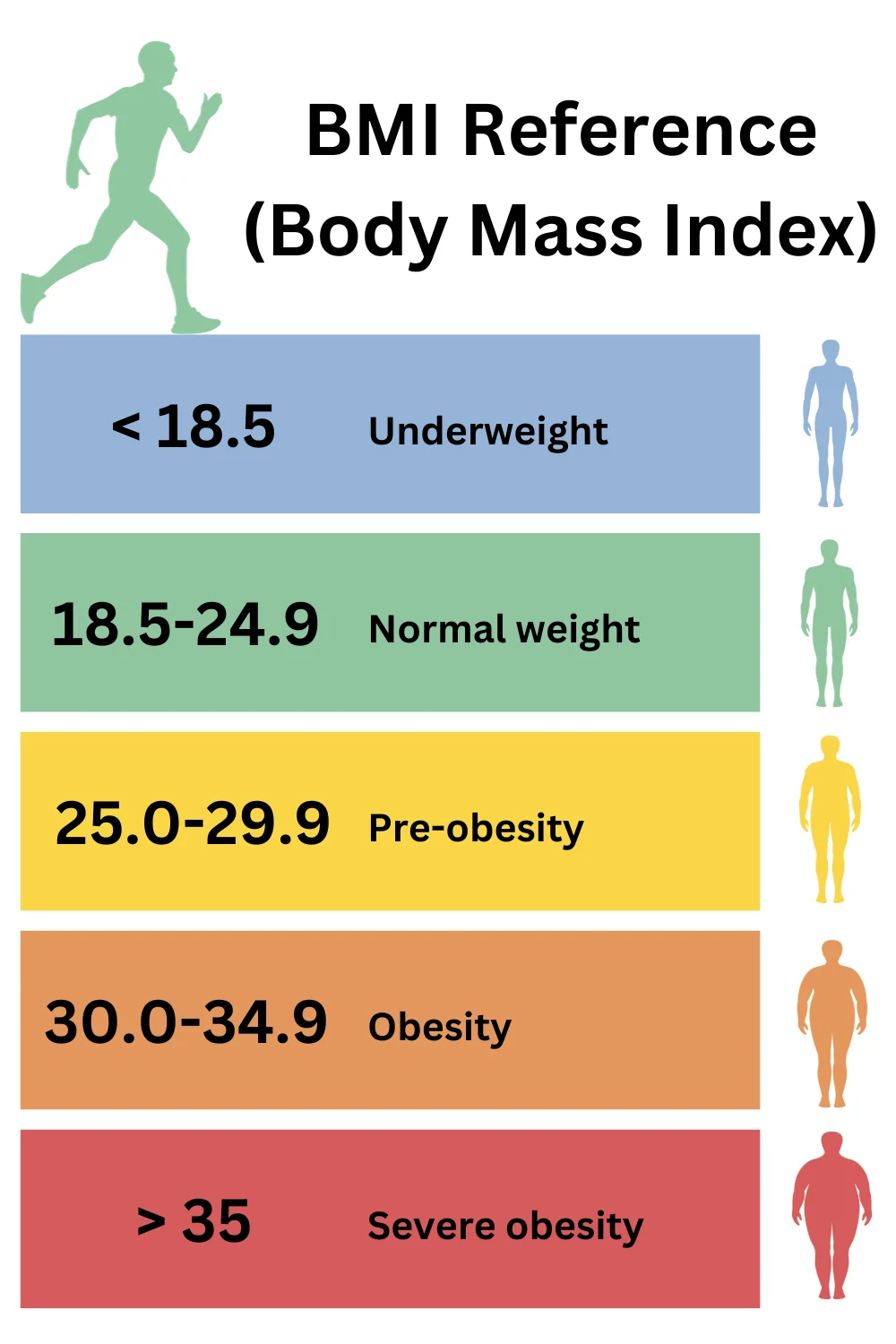![]()
Most Popular Calculators
Calculators to try next:
What is the BMI calculator?
The BMI calculator is a tool that calculates your Body Mass Index (BMI), based on your weight and height. BMI is a number that can be used to quickly assess whether you are a healthy weight for a typical adult of your height. A healthy BMI is between 18.5 and 24.9. If your BMI is outside of this range, it is classified as underweight, overweight or obese.
This tool uses the standard BMI classification and is suitable for adults over the age of 18 only. To calculate the BMI for a person aged between 2 and 17 years old, use a child and teen’s BMI calculator.
Planning to lose or gain weight? You might want to try our Reverse BMI Calculator that provides a target weight given your desired BMI.
What is BMI?
BMI stands for “Body Mass Index“. It is a widely used method to assess whether a person has a healthy body weight. It is a simple calculation based on your weight and height. You can use the number produced by this calculation to compare your personal BMI against the standard reference ranges used by healthcare professionals.
The World Health Organization (WHO) categorize BMI using the following ranges:
- Below 18.5 – Underweight
- Between 18.5 and 24.9 – Normal weight
- Between 25.0 and 29.9 – Pre-obesity (overweight)
- Between 30.0 and 34.9 – Obesity class I
- Between 35.0 and 39.9 – Obesity class II
- Above 40 – Obesity class III

Risks of overweight
According to the CDC, people with a BMI over 25 (overweight and obese), are at an increased risk of disease and health complaints.
Health conditions associated with overweight and obesity include:
- Heart disease and stroke – Extra weight makes you more likely to have high blood pressure and high cholesterol, both risk factors for heart disease and stroke.
- Type 2 diabetes – Overweight and obese individuals are at higher risk of developing type 2 diabetes. A 2007 study showed that being overweight or obese, particularly at a young age, substantially increases the risk of diabetes.
- Cancer – Being overweight or obese is associated with a higher risk of many types of cancer, including lung cancer, colorectal cancer, prostate cancer and breast cancer.
- Osteoarthritis – Excess weight can put unnecessary pressure on joints, leading to wear and tear. The impact of osteoarthritis increases with a higher BMI.
Risks of underweight
Being underweight is associated with several health risk, including:
- Undernourishment and malnourishment: These conditions occur when your body isn’t receiving the necessary nutrients it needs to function efficiently, leading to tiredness, weakness and other issues. A BMI under 18.5 may put you at risk of becoming under-nourished.
- Osteoporosis: BMI is positively associated with bone mineral density. If you have low bone mineral density, your bones can become fragile, making them more prone to fractures. BMI at the upper end of the normal range (18.5 to 24.9) may reduce the risk of osteoporosis.
Limitations of BMI
The primary limitation of using BMI as a healthy weight indicator is that it does not take into account your body’s fat content. BMI is calculated using only your weight and height, but it doesn’t differentiate between weight from muscle and weight from fat.
If you have a high muscle mass, you may have a high BMI and be categorized as overweight or obese. Athletes and individuals who participate in strength training or other sports that contribute to muscle growth often have higher BMIs.
While BMI can be a useful tool, it should be used in conjunction with other methods when evaluating the state of your overall health and fitness.
Despite its limitations, BMI is a useful measure for the majority of people. BMI can provide a reasonably accurate assessment of whether you are underweight, normal weight, overweight or obese. It is an accessible and easy-to-understand measurement that can be a starting point for deeper conversations about your health, diet, and exercise.
Not suitable for
Do not use our BMI calculator:
- If you are pregnant – BMI will not provide an accurate reflection of your health status as your body undergoes significant changes during pregnancy. Consult a doctor or medical professional if you are concerned about your weight.
- If you have an eating disorder – Always consult a medical professional about your weight.
- If you have a medical condition that affects your height – BMI might not provide a accurate assessment of your health.
- If you are under the age of 18 – BMI is not a suitable measure of healthy weight for children and teens under the age of 18.
How to use our BMI calculator
First, input your height. You can select either feet (ft) and inches (in) or centimeters (cm).
Next, input your weight. You can do this in either kilograms (kg) or pounds (lbs).
Finally, click the "Calculate BMI" button. The calculator will output your BMI value, along with the weight status. This will be one of underweight, normal weight, overweight, obese or severely obese.
BMI Formula
The Body Mass Index (BMI) formula is simple calculation to assess whether you have a healthy weight. The formula for calculating BMI is:
BMI = Weight (kg) / [Height (m)]2
The formula takes your weight in kilograms and divides it by your height squared.
References
World Health Organization. (2010). A healthy lifestyle – WHO recommendations. World Health Organisation. https://www.who.int/europe/news-room/fact-sheets/item/a-healthy-lifestyle—who-recommendations
Centers for Disease Control and Prevention. (2022). The health effects of overweight and obesity. Centers for Disease Control and Prevention; Centers for Disease Control and Prevention. https://www.cdc.gov/healthyweight/effects/index.html
Lu, Y., Hajifathalian, K., Ezzati, M., Woodward, M., Rimm, E. B., Danaei, G., & D’Este, C. (2014). Metabolic mediators of the eff ects of body-mass index, overweight, and obesity on coronary heart disease and stroke: a pooled analysis of 97 prospective cohorts with 1.8 million participants.
Narayan, K. V., Boyle, J. P., Thompson, T. J., Gregg, E. W., & Williamson, D. F. (2007). Effect of BMI on lifetime risk for diabetes in the US. Diabetes care, 30(6), 1562-1566.
Calle, E. E., Rodriguez, C., Walker-Thurmond, K., & Thun, M. J. (2003). Overweight, obesity, and mortality from cancer in a prospectively studied cohort of US adults. New England Journal of Medicine, 348(17), 1625-1638.
Raud, B., Gay, C., Guiguet-Auclair, C., Bonnin, A., Gerbaud, L., Pereira, B., … & Coudeyre, E. (2020). Level of obesity is directly associated with the clinical and functional consequences of knee osteoarthritis. Scientific reports, 10(1), 3601.
Underweight. (n.d.). Great Western Hospital. https://www.gwh.nhs.uk/wards-and-services/nutrition-and-dietetics/specific-support/underweight/
Lee, J. H., Kim, J. H., Hong, A. R., Kim, S. W., & Shin, C. S. (2020). Optimal body mass index for minimizing the risk for osteoporosis and type 2 diabetes. The Korean journal of internal medicine, 35(6), 1432.


